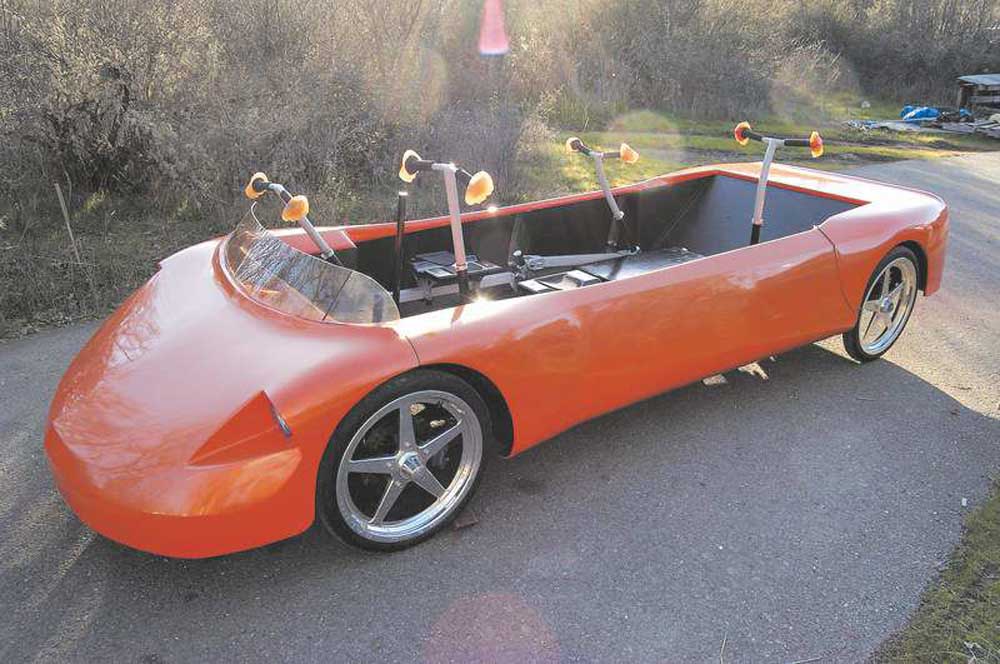Driving a human-powered car
Published 5:00 am Monday, March 18, 2013

- An advanced prototype of the Imagine PS, a human-powered electric car developed by HumanCar Inc. of Cave Junction. Pushing forward and pulling back on the T-bar, which also aids steering, powers the car. The vehicle can also be used as a regular plug-in electric hybrid.
Later this week, Oregonians should keep an eye out for a bright orange convertible operated by two people who look more like they’re getting a cardio workout than driving a car.
The father and son behind HumanCar plan to show off their latest model, a human-powered/plug-in electric hybrid, Thursday in Salem as they start their “Oregon Tour of Technology.”
Trending
People power the Imagine PS by pulling and pushing on a T-bar, or handlebar, connected to a vertical shaft, similar to the rowing motion of a crew team. The energy they create powers the car. The occupants also steer by leaning their bodies and moving the handlebar in the same direction, similar to steering a motorcycle.
The Imagine seats four, but it can be powered by a single person, said Chuck Greenwood, a Bend resident and HumanCar’s information officer. It also works as a plug-in electric hybrid for those who don’t want to pump up the power.
But he and his father, Charles Samuel Greenwood, professional engineer, chief scientist and HumanCar inventor, see their technology as more than a car. It’s a technological breakthrough, they say, similar to the steam engine, the light bulb or computer.
“It’s a much, much bigger idea,” Chuck Greenwood said. “The car is a metaphorical vehicle.”
Powering the car can provide a good workout, reducing obesity, and it also offers a team-building exercise, he said. It uses no natural resources like oil and it doesn’t pollute.
HumanCars can provide economic development, Greenwood said. They can be built anywhere, in what the company calls its easy-to-set-up factory in a box, or drop shop, that can employ 30 to 35 people.
Trending
The Imagine’s power plant doubles as a human-powered generator, which can also be used separately and folds down to the size of a travel suitcase, he said. One person operating it twice a day for 30 minutes can generate enough power to run a small refrigerator.
The generator can be used anywhere. Some East Coast residents could have used it in the wake of Hurricane Sandy, Greenwood said.
“It’s not green, red or blue,” he said, referring to the vehicle and its technology. “It just saves money. That’s HumanCar.”
The concept came to his father about 45 years ago as he sat in traffic in the San Francisco Bay Area, according to an interview on the company’s website. If vehicles moved on a guided-road system that powered and controlled them, he thought at the time, they could be built with less weight and power, he told Society and Environment magazine.
In his Cave Junction workshop, Charles Greenwood made several prototypes, including the FM-4, a skeletonized vehicle that led to the Imagine PS.
HumanCar began generating worldwide publicity in the middle of the last decade, with write-ups in Popular Science and on Wired.com, and video segments on CNN, Japan’s NHK network and Discovery Network’s “Daily Planet.” One video on HumanCar’s YouTube channel has been viewed nearly 1.4 million times.
But the company lowered its profile over the last couple of years, partly due to the economy, but mostly to fine tune the technology.
“We don’t want to beta test on the public,” Chuck Greenwood said. “(We took time) woodshedding the technology until it was totally right.”
It apparently worked.
Emmaline Pohnl, program manager for Drive Oregon, which promotes the state’s electrical vehicle industry, had not heard of HumanCar until she was contacted Friday and visited its website.
“I’ve worked in this industry for a year and a half,” she said, “and I’ve never seen anything like that.”
The Greenwoods plan to reintroduce HumanCar on Thursday in Salem at the Capitol. Another stop is planned in Eugene at the University of Oregon, but the technology tour will mostly be a series of public demonstrations at various locations throughout the spring. Events will be posted on HumanCar’s website.
While the company has received about 500 preorders, it needs about 1,000 before it can begin producing cars economically, Chuck Greenwood said. Then they could be sold for $10,000-$15,000,
The Imagine PS will be built as a neighborhood-electric vehicle, which falls under the federal low-speed vehicle standards. Production models will have all required safety equipment, which the prototype that appears in many of the company’s images does not have, Chuck Greenwood said.
Under Oregon law, such vehicles have a maximum speed of 35 mph, so HumanCar plans to limit the car’s speed.
“We’ve gone pretty fast in it,” he said. “But it’s limited to the guidelines of street legality.”
As a company, the Greenwoods say, HumanCar has a 200-year business plan. They see the Imagine PS as only the beginning. Plans call for a high-speed model, capable of reaching 150 mph. They also call the Imagine “power agnostic,” meaning it can work with any type of motor, even one that does not yet exist.
“It can use any motor source,” Chuck Greenwood said. “It’s (like) an operating system for your car. You just upgrade the software.”








